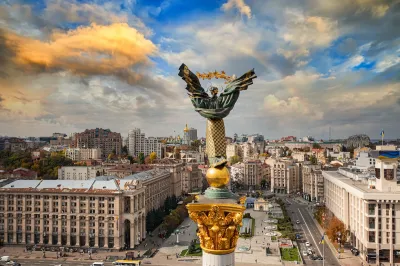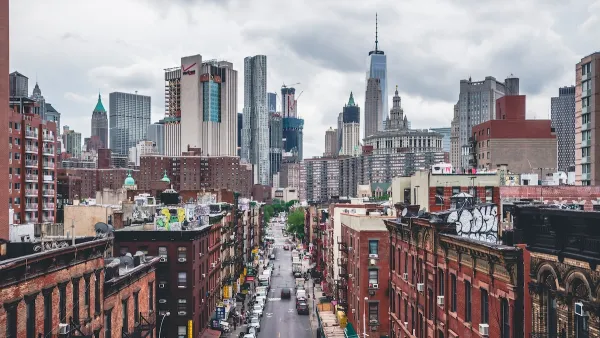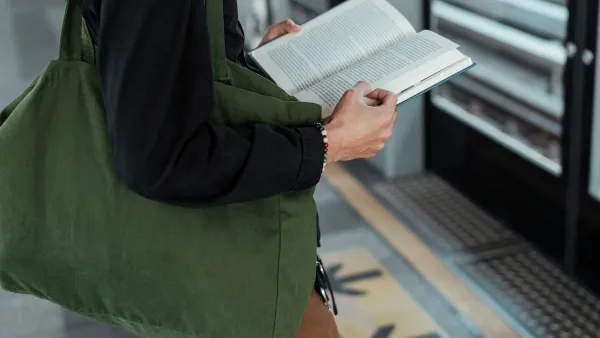The first in a series of posts reflecting on urbanism and rebuilding efforts in Ukraine following the Russian invasion in 2022.

This is the first in a series of posts reflecting on urbanism and rebuilding efforts in Ukraine following the Russian invasion in 2022.
I have learned that war is noise. The drums of war are deafening here in Kyiv and in other Ukrainian cities, with constant air raid sirens and explosions as the air defense shoots down incoming Russian missiles. Occasionally a missile makes it through, rocking the entire neighborhood and triggering shrieking car alarms. And there’s the groan of military and aid vehicles rumbling through the streets.
But if you listen closely, below that thunderous percussion, a quiet orchestra of string instruments is playing.
I came to Ukraine in 2022 after receiving an appeal from urban planning colleagues asking me if I could bring used bicycles to the country. I responded immediately and eagerly. Little did I know that I would end up dedicating two and a half years — and counting — to helping the people of Ukraine with both bicycles and urbanism.
The music started with the arrival of used bicycles, which are now used to deliver humanitarian aid, food, water, and medicine to the most vulnerable citizens in the most devastated areas. Social workers and volunteers pedal tirelessly in over 35 cities and towns on bicycles laden with essential goods. A long list of urbanism and architecture projects now contribute to the orchestra.
I have seen the power of urbanism in my work shaping the urban landscape in over 100 cities around the world. Now I am using the skills and experience gained from that work to help the people of Ukrainian cities. My time in Ukraine, however, has been a continuous series of epiphanies, both personal and professional. It is at once inspiring and humbling.
I have learned that urbanism is about more than designing and building life-sized cities. It isn’t just about designing streets or public spaces — it is an integral tool for survival. Amid the chaos of air raid sirens and missile strikes, something as simple as planting a tree with your neighbours becomes a pivotal act that removes you from the harshest of realities.
Urbanism can also help heal the wounds of war. Here in Kyiv, I designed and built the first Nordic therapy garden to heal mental trauma and PTSD and did so with over 1,000 volunteers over 11 weekends. Both work and garden therapy for a common, important goal is as essential for these friends of mine as it is for me.
Whether I’m designing pop-up temporary urbanism projects, trauma-sensitive parks, the typology for new homes using sustainable and traditional architecture, or delivering the latest shipment of used bicycles to de-occupied regions, each and every moment is amplified. Our humble string orchestra reaches crescendos that sometimes rise above the bombastic noise.
Urbanism is not a cure for the brutality of this invasion, but I have learned that it can be a powerful medicine. It offers a sense of control and improvement, a moment of peace, purpose, and connection. Power cuts and missile attacks are gently pushed to the back of our minds as we make our street or neighborhood just a little bit better. These initiatives help people regain control of their lives.
A city isn’t just a place. It’s a community. In times of war, every tree planted or park landscaped can lift spirits and remind people that life, despite everything, continues.
I came to Ukraine because of a personal and professional appeal. I stayed because Ukrainians are dying to defend their nation and also, quite literally, Europe — including my children and my friends. I have learned what resilience means, taught by some of the strongest people I could ever hope to meet. The name of the urbanism non-profit I’ve started with Ukrainians is appropriate: DIY Ukraine.
I have no end game. I wake up every morning, seven days a week and get to work, which is far from finished. It is an odd existence but always rewarding, and the reality is harsh: 40 percent of Ukrainians still need regular humanitarian aid and soldiers are returning home with mental trauma and amputations. Ukrainians (including a growing number of friends) are dying while defending their nation, but they are also defending Europe, my family, and my friends.
For all my musical metaphors in this piece, I look forward to the day when we can remove three letters from Resilience and enjoy Silence. Until then, if my skills in urbanism and architecture can help, I will continue. Because I can. Because I must.
Mikael Colville-Andersen is an urban designer, author and a leading global voice in urbanism. He has worked in over 100 cities around the world, advising about how to design — and embrace — bicycle- and pedestrian-friendly streets to improve urban life. He is known for his pioneering philosophies about simplifying urban planning and how cities and towns should be designed instead of engineered. Mikael is also the host of the global documentary series about urbanism The Life-Sized City. He inspires with examples from around the world about how cities and citizens are the key to tackling climate change through design thinking in this, the Age of Urbanism. He currently works in Ukraine, redesigning bombed cities and sending used bikes to the country with his NGOs Bikes4Ukraine.org and DIY-Ukraine.com.

National Parks Layoffs Will Cause Communities to Lose Billions
Thousands of essential park workers were laid off this week, just before the busy spring break season.

Retro-silient?: America’s First “Eco-burb,” The Woodlands Turns 50
A master-planned community north of Houston offers lessons on green infrastructure and resilient design, but falls short of its founder’s lofty affordability and walkability goals.

Delivering for America Plan Will Downgrade Mail Service in at Least 49.5 Percent of Zip Codes
Republican and Democrat lawmakers criticize the plan for its disproportionate negative impact on rural communities.

Test News Post 1
This is a summary

Test News Headline 46
Test for the image on the front page.

Balancing Bombs and Butterflies: How the National Guard Protects a Rare Species
The National Guard at Fort Indiantown Gap uses GIS technology and land management strategies to balance military training with conservation efforts, ensuring the survival of the rare eastern regal fritillary butterfly.
Urban Design for Planners 1: Software Tools
This six-course series explores essential urban design concepts using open source software and equips planners with the tools they need to participate fully in the urban design process.
Planning for Universal Design
Learn the tools for implementing Universal Design in planning regulations.
EMC Planning Group, Inc.
Planetizen
Planetizen
Mpact (formerly Rail~Volution)
Great Falls Development Authority, Inc.
HUDs Office of Policy Development and Research
NYU Wagner Graduate School of Public Service





























